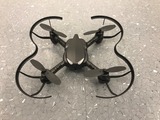
This is an introductory level textbook for control engineering.
- Subject:
- Engineering
- Material Type:
- Textbook
- Author:
- XIANGYU MENG
- Date Added:
- 01/04/2021


This is an introductory level textbook for control engineering.
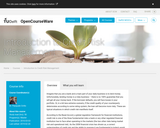
Imagine that you are a bank and a main part of your daily business is to lend money. Unfortunately, lending money is a risky business – there is no 100% guarantee that you will get all your money back. If the borrower defaults, you will face losses in your portfolio. Or, in a bit less extreme scenario, if the credit quality of your counterparty deteriorates according to some rating system, the loan will become more risky. These are typical situations in which credit risk manifests itself.
According to the Basel Accord, a global regulation framework for financial institutions, credit risk is one of the three fundamental risks a bank or any other regulated financial institution has to face when operating in the markets (the two other risks being market risk and operational risk). As the 2008 financial crisis has shown us, a correct understanding of credit risk and the ability to manage it are fundamental in today’s world.
This course offers you an introduction to credit risk modelling and hedging. We will approach credit risk from the point of view of banks, but most of the tools and models we will overview can be beneficial at the corporate level as well.
At the end of the course, you will be able to understand and correctly use the basic tools of credit risk management, both from a theoretical and, most of all, a practical point of view. This will be a quite unconventional course. For each methodology, we will analyse its strengths as well as its weaknesses. We will do this in a rigorous way, but also with fun: there is no need to be boring.
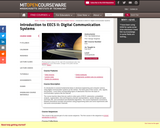
An introduction to several fundamental ideas in electrical engineering and computer science, using digital communication systems as the vehicle. The three parts of the course - bits, signals, and packets - cover three corresponding layers of abstraction that form the basis of communication systems like the Internet. The course teaches ideas that are useful in other parts of EECS: abstraction, probabilistic analysis, superposition, time and frequency-domain representations, system design principles and trade-offs, and centralized and distributed algorithms. The course emphasizes connections between theoretical concepts and practice using programming tasks and some experiments with real-world communication channels.

This course is an introductory subject in the field of electric power systems and electrical to mechanical energy conversion. Electric power has become increasingly important as a way of transmitting and transforming energy in industrial, military and transportation uses. Electric power systems are also at the heart of alternative energy systems, including wind and solar electric, geothermal and small scale hydroelectric generation.

This open book aims to help students develop a fundamental understanding of classical thermodynamics and its engineering applications. It features concise explanations of key concepts, step-by-step engineering examples, and interactive practice problems at the end of each section. It is most suitable for a one-term, introductory engineering thermodynamics course at the undergraduate level. It may also be used as self-learning materials or a supplement to other thermodynamics books. The book is licensed under a CC-BY-NC-SA license.

Broadly speaking, functional programming is a style of programming in which the primary method of computation is the application of functions to arguments. Among other features, functional languages offer a compact notation for writing programs, powerful abstraction methods for structuring programs, and a simple mathematical basis that supports reasoning about programs.
Functional languages represent the leading edge of programming language design, and the primary setting in which new programming concepts are introduced and studied. All contemporary programming languages such as Hack/PHP, C#, Visual Basic, F#, C++, JavaScript, Python, Ruby, Java, Scala, Clojure, Groovy, Racket, … support higher-order programming via the concept of closures or lambda expressions.
This course will use Haskell as the medium for understanding the basic principles of functional programming. While the specific language isn’t all that important, Haskell is a pure functional language so it is entirely appropriate for learning the essential ingredients of programming using mathematical functions. It is also a relatively small language, and hence it should be easy for you to get up to speed with Haskell.
Once you understand the Why, What and How that underlies pure functional programming and learned to “think like a fundamentalist”, we will apply the concepts of functional programming to “code like a hacker” in mainstream programming languages, using Facebook’s novel Hack language as our main example.
This course assumes no prior knowledge of functional programming, but assumes you have at least one year of programming experience in a regular programming language such as Java, .NET, Javascript or PHP.
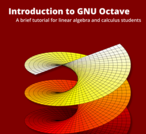
These notes are intended to provide a brief, noncomprehensive introduction to GNU Octave, a free open source alternative to MatLab. The basic syntax and usage is explained through concrete examples from the mathematics courses a math, computer science, or engineering major encounters in the first two years of college: linear algebra, calculus, and differential equations.

These notes are intended to provide a brief, noncomprehensive introduction to GNU Octave, a free open source alternative to MatLab. The basic syntax and usage is explained through concrete examples from the mathematics courses a math, computer science, or engineering major encounters in the first two years of college: linear algebra, calculus, and differential equations.

This book was created for an undergraduate Introduction to Industrial Engineering course at The University of Texas at Arlington (UTA). The chapters give an overview of the profession and an introduction to some of the tools used by industrial engineers in industry. There are interactive content exercises included at the end of most chapters. This interactive content aims to engage students in the content as they are reading. The book will continue to revised and updated with new information as it becomes necessary.
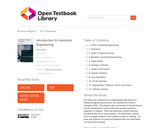
This book was created for an undergraduate Introduction to Industrial Engineering course at The University of Texas at Arlington (UTA). The chapters give an overview of the profession and an introduction to some of the tools used by industrial engineers in industry. There are interactive content exercises included at the end of most chapters. This interactive content aims to engage students in the content as they are reading. The book will continue to revised and updated with new information as it becomes necessary.
Table of Contents
1. What is Industrial Engineering?
2. Teamwork
3. What is Problem Solving?
4. Big Ideas in Industrial Engineering
5. Using Models
6. Deming's 14 Points
7. People in the System
8. Systems Thinking
9. Lean Operations
10. The IE Approach
11. Organizations' Missions, Visions, and Values
12. Lifelong Learning
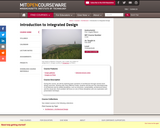
During this course, we will be exploring basic questions of architecture through several short design exercises. Working with many different media, students will discover the interrelationship of architecture and its related disciplines, such as structures, sustainability, architectural history and the visual arts. Each problem will focus on one of these disciplines and one exploration and presentation technique.
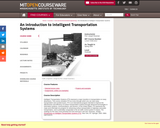
Basic elements of intelligent transportation systems. Technological, systems, and institutional aspects of ITS considered, including system architecture, congestion pricing, public/private partnerships, network models, ITS as industrial policy, and implementation case studies. Intelligent Transportation Systems (ITS) represent a major transition in transportation on many dimensions. This course considers ITS as a lens through which one can view many transportation and societal issues. ITS is an international program intended to improve the effectiveness and efficiency of surface transportation systems through advanced technologies in information systems, communications, and sensors. In the United States, ITS represents the major post-Interstate-era program for advancing surface transportation in highways and public transportation, and is potentially comparable to the air traffic control system in impact.
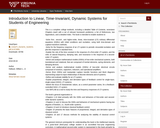
The general minimum prerequisite for understanding this book is the intellectual maturity of a junior-level (third-year) college student in an accredited four-year engineering curriculum. A mathematical second-order system is represented in this book primarily by a single second-order ODE, not in the state-space form by a pair of coupled first-order ODEs. Similarly, a two-degrees-of-freedom (fourth-order) system is represented by two coupled second-order ODEs, not in the state-space form by four coupled first-order ODEs. The book does not use bond graph modeling, the general and powerful, but complicated, modern tool for analysis of complex, multidisciplinary dynamic systems. The homework problems at the ends of chapters are very important to the learning objectives, so the author attempted to compose problems of practical interest and to make the problem statements as clear, correct, and unambiguous as possible. A major focus of the book is computer calculation of system characteristics and responses and graphical display of results, with use of basic (not advanced) MATLAB commands and programs. The book includes many examples and homework problems relevant to aerospace engineering, among which are rolling dynamics of flight vehicles, spacecraft actuators, aerospace motion sensors, and aeroelasticity. There are also several examples and homework problems illustrating and validating theory by using measured data to identify first- and second-order system dynamic characteristics based on mathematical models (e.g., time constants and natural frequencies), and system basic properties (e.g., mass, stiffness, and damping). Applications of real and simulated experimental data appear in many homework problems. The book contains somewhat more material than can be covered during a single standard college semester, so an instructor who wishes to use this as a one-semester course textbook should not attempt to cover the entire book, but instead should cover only those parts that are most relevant to the course objectives.
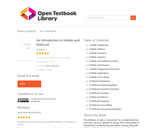
This textbook, or really a “coursebook” for a college freshman-level class, has been updated for Spring 2014 and provides an introduction to programming and problem solving using both Matlab and Mathcad. We provide a balanced selection of introductory exercises and real-world problems (i.e. no “contrived” problems). We include many examples and screenshots to guide the reader. We assume no prior knowledge of Matlab or Mathcad.
Table of Contents
1 Matlab: Introduction
2 Matlab: Matrices
3 Matlab: Functions
4 Matlab: Graphics
5 Matlab: User Defined Functions
6 Matlab: Input/Output
7 Matlab: Programming Structures
8 Matlab: Applications
9 Matlab: Curve Fitting
10 Matcad: Introduction
11 Mathcad: Entering Equations
12 Mathcad: Given/Find and Solve
13 Mathcad: Functions
14 Mathcad: Matrices
15 Mathcad: Graphing
16 Mathcad: Curve Fitting
17 Mathcad: Calculus and Symbolics
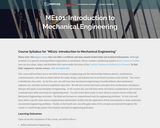
This course will introduce the student to the field of mechanical engineering and the interplay of physics, mathematics, communications, and sciences necessary for the study, design, and manufacture of mechanical products and systems. The course culminates with a small design project. Upon successful completion of this course, the student will be able to: Define mechanical engineering; Describe some subfields of mechanical engineering; Distinguish mechanical engineering from other types of engineering; Describe important components of engineering design and project management; Employ engineering measurements, units, and conversions; Demonstrate an understanding of engineering ethics and ethical dilemmas; Describe intellectual property and copyright issues in an engineering context; Perform basic oral and written technical communication according to accepted standards in an engineering context; Perform several basic computations in Scilab, including matrix manipulations and nonlinear equation solving; Perform data analysis and display using Scilab; Demonstrate an understanding of all of the above through execution of an engineering design project. (Mechanical Engineering 101)
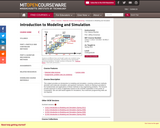
This subject provides an introduction to modeling and simulation, covering continuum methods, atomistic and molecular simulation, and quantum mechanics. Hands-on training is provided in the fundamentals and applications of these methods to key engineering problems. The lectures provide exposure to areas of application based on the scientific exploitation of the power of computation. We use web based applets for simulations, thus extensive programming skills are not required.
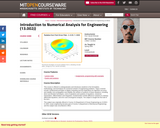
This course is offered to undergraduates and introduces students to the formulation, methodology, and techniques for numerical solution of engineering problems. Topics covered include: fundamental principles of digital computing and the implications for algorithm accuracy and stability, error propagation and stability, the solution of systems of linear equations, including direct and iterative techniques, roots of equations and systems of equations, numerical interpolation, differentiation and integration, fundamentals of finite-difference solutions to ordinary differential equations, and error and convergence analysis. The subject is taught the first half of the term. This class was originally listed in Course 13 (Ocean Engineering) as 13.002J.
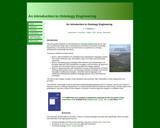
This first general textbook An introduction to ontology engineering has as main aim to provide the reader with a comprehensive introductory overview of ontology engineering. A secondary aim is to provide hands-on experience in ontology development that illustrate the theory.

This course presents aerospace propulsive devices as systems, with functional requirements and engineering and environmental limitations along with requirements and limitations that constrain design choices. Both air-breathing and rocket engines are covered, at a level which enables rational integration of the propulsive system into an overall vehicle design. Mission analysis, fundamental performance relations, and exemplary design solutions are presented.

This set of 10 lectures (about 11+ hours in duration) was excerpted from a three-day course developed at MIT Lincoln Laboratory to provide an understanding of radar systems concepts and technologies to military officers and DoD civilians involved in radar systems development, acquisition, and related fields. That three-day program consists of a mixture of lectures, demonstrations, laboratory sessions, and tours.